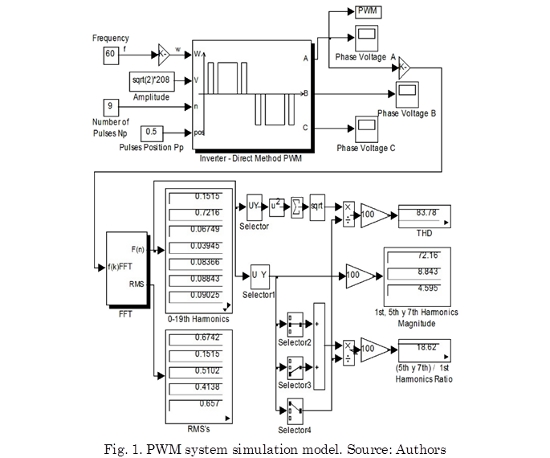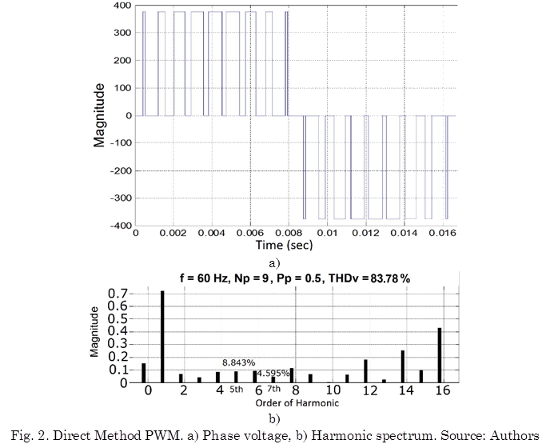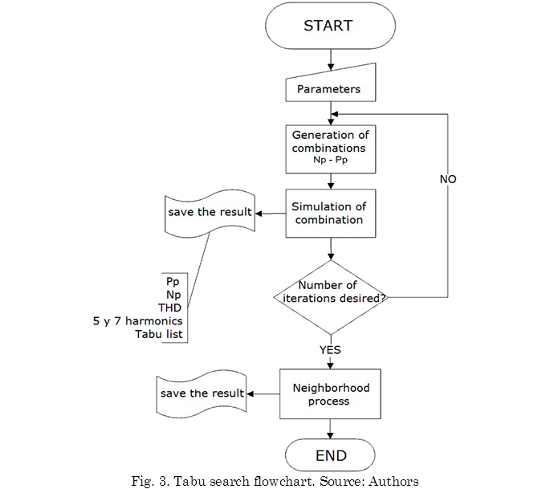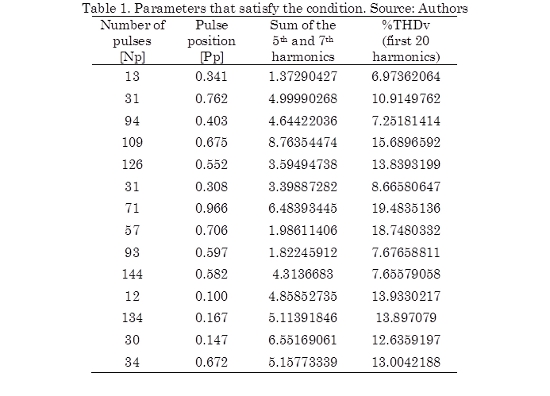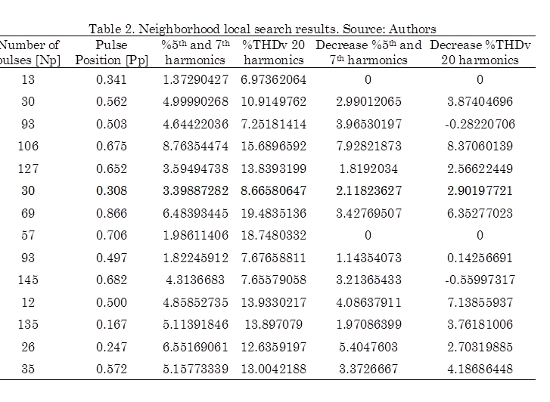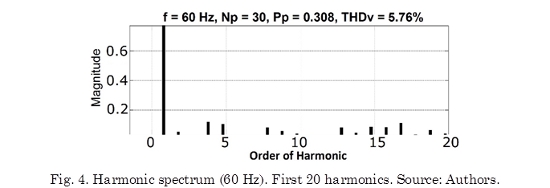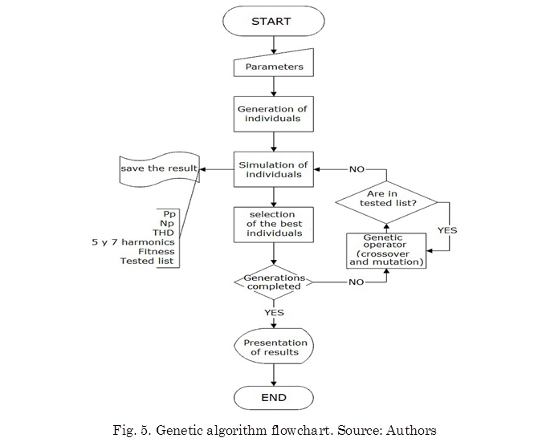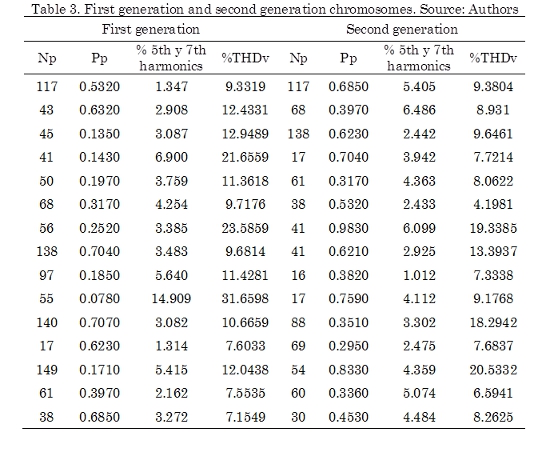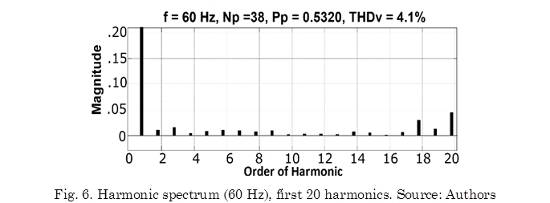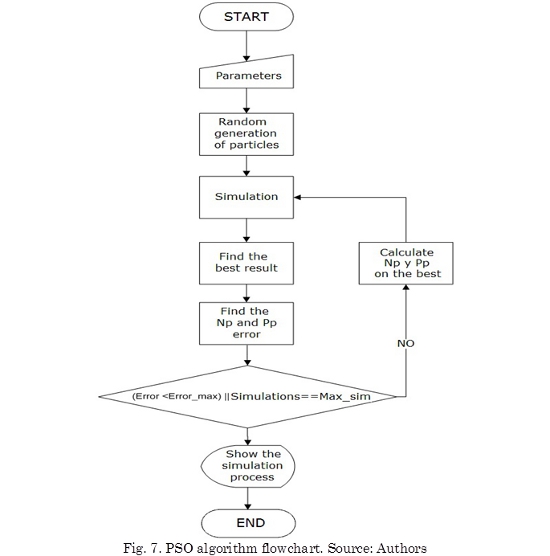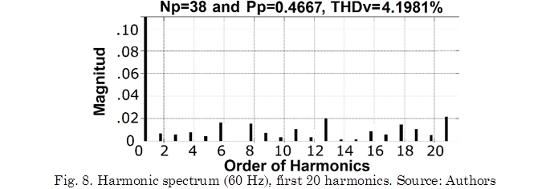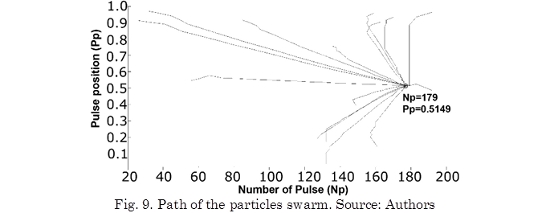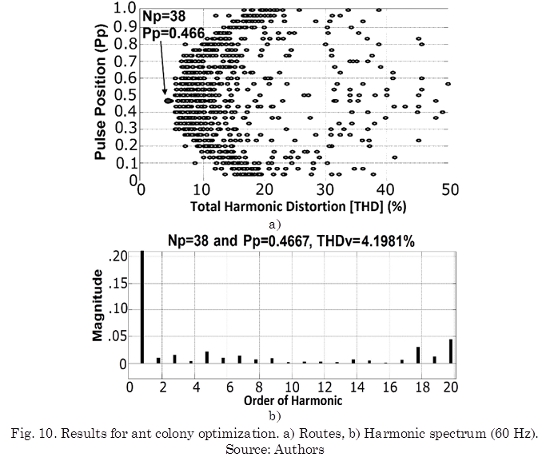Services on Demand
Journal
Article
Indicators
-
 Cited by SciELO
Cited by SciELO -
 Access statistics
Access statistics
Related links
-
 Cited by Google
Cited by Google -
 Similars in
SciELO
Similars in
SciELO -
 Similars in Google
Similars in Google
Share
TecnoLógicas
Print version ISSN 0123-7799On-line version ISSN 2256-5337
TecnoL. vol.18 no.34 Medellín Jan./June 2015
Artículo de investigación/Research article
Bioinspired algorithms for optimizing the harmonics contents of a PWM power inverter
Algoritmos bioinspirados para optimizar el contenido de armónicos de un inversor de potencia PWM
Jorge L. Díaz-Rodríguez1, Oscar E. Gualdrón-Guerrero2, Aldo Pardo-García3
1Master in Science in Automatic Control, Dept. Electrical and Computer Engineering, University of Pamplona, Pamplona-Colombia, jdiazcu@gmail.com
2Ph.D. Electronic Engineering, Dept. Electrical and Computer Engineering, University of Pamplona, Pamplona-Colombia, oscar.gualdron@unipamplona.edu.co
3Ph.D. Electric Engineering, Dept. Electrical and Computer Engineering, University of Pamplona, Pamplona-Colombia, apardo13@hotmail.com
Fecha de recepción: 27 de mayo de 2014 / Fecha de aceptación: 21 de octubre de 2014
Como citar / How to cite
J. L. Díaz-Rodríguez, O. E. Gualdrón-Guerrero y A. Pardo-García, “Bioinspired Algorithms for optimizing the harmonics contents of a PWM Power Inverter”, Tecno Lógicas, vol. 18, no. 34, pp. 63-74, 2015.
Abstract
This paper deals with the evaluation of different bio-inspired algorithms techniques for reduction of harmonic distortion (THD) in pulse width modulation (PWM) of power inverters. A comprehensive study is performed, that identifies and develops biologically inspired optimization algorithms based mainly on tabu search, genetic algorithms (GA), particle swarm optimization (PSO), and ant colony optimization (ACO). These bio-inspired optimization methods were used to find the best operational parameters of a PWM applied to a power inverter. The best results were achieved when the pulse position is near to the middle position (Pp=0.5) or symmetry of the pulse. For the four methods analyzed he best result was obtained using ACO method based on the lowest THD content and less 5th and 7th harmonics magnitude with fewer pulses (Np=38), almost 5 times lower than the result of PSO (Np=179). It was achieved to reduce losses considerably with a reduction in the switching frequency of the power devices (4560 Hz). The algorithms developed can be easily adapted to any minimization problem, only making changes in the number of variables and selection (or elimination) criteria to obtain better results in complex problems.
Keywords: Pulse width modulation, tabu search, genetic algorithm, ant colony optimization, particle swarm optimization.
Resumen
Este trabajo se centra en la evaluación de diferentes técnicas de algoritmos bio-inspirados, que permitan reducir la distorsión armónica (THD) de la modulación de ancho de pulso (PWM) en inversores de potencia. Se realizó un amplio estudio que identifica y desarrolla algoritmos de optimización de inspiración biológica basados principalmente en la búsqueda tabú, algoritmos genéticos, optimización por enjambre de partículas y colonia de hormigas. Los métodos de optimización bio-inspirados son usados principalmente para encontrar los mejores parámetros operacionales de un PWM aplicado a inversores de potencia. Los mejores resultados fueron obtenidos cuando la posición de pulso (Pp) se localiza cerca a la posición central (Pp=0.5) o a la simetría del pulso. Dentro de los cuatro métodos estudiados el mejor resultado se encontró usando la técnica de optimización por colonia de hormigas, debido al valor de THD más bajo encontrado e igualmente con el 5 y 7 armónico con menos impulsos (Np= 38), casi 5 veces menor que el resultado usando la técnica optimización por enjambre de partículas, logrando reducir considerablemente las pérdidas bajando la frecuencia de conmutación (4560 Hz) de los dispositivos de potencia. Los algoritmos desarrollados pueden fácilmente adaptarse a cualquier problema de optimización, solo haciendo cambios en el número de variables y en la selección (o eliminación) de los criterios y así de esta manera obtener mejores resultados en problemas complejos.
Palabras clave: Modulación por ancho de pulso, búsqueda tabú, algoritmos genéticos, optimización colonia de hormigas, optimización por enjambre de partículas.
1. Introduction
The use of Pulse Width Modulation (PWM) techniques in the control of electrical machines generates harmonics that produce heat and braking torques that cause energy losses, less efficiency and a reduced lifetime. To solve this problem, is required to determine optimal adjustment
Biologically inspired optimization techniques are very useful when in necessary to solve complex problems using computer algorithms. Without establishing any mathematical classical optimization, the optimization problem can be solved numerically, finding optimal values [2], to find the suitable parameters to reduce the harmonic distortion (THD) in a PWM inverter.
In specialized literature can be found the application of genetic algorithms to optimize the PWM modulation, in the early work is that of Shi and Li [3]. In the above paper, a genetic algorithm is applied to optimize a PWM power inverter, with sinusoidal PWM (SPWM) and random PWM. However, both modulations do not constitute an appropriate starting point; it can be, added other parameters such as triangular asymmetry or use other PWM technique to ensure lower harmonic distortion content as the direct method PWM [4]. Others harmonic optimization criteria, beside THD, can also be used minimization or fitness as the 5th and 7th harmonics magnitude, which are the most representative of lower order produced by the inverter, because the 3rd order harmonic are suppressed with a properly motor connection.
1.1 Direct Method PWM
The main advantage of using the direct PWM method is not dependent on classical comparison of a sinusoidal modulating signal with a triangular carrier signal as in the case of PWM sinusoidal modulation (SPWM). The direct method PWM algorithm generates switching angles (pulses positions) that are determined using numerical methods by reproducing a pulse shaped waveform patterns with the equivalent area of a sinusoid, thus maintaining the same root mean square (RMS) voltage.
1.1.1 Direct method PWM Simulation
The direct method PWM is developed using Simulink®, with the Inverter - Direct Method PWM block that generates the PWM with a phase shift of 120 degrees (three phase). The block has the following inputs: frequency (f), amplitude (V), number of pulses (Np) and pulse position (Pp). Fig. 1 shows the PWM simulation model and the computation of the harmonic content (THD) including the 5th and 7th harmonics and it relation to the fundamental component (1st harmonic).
Fig. 2a shows the output PWM voltage, with a frequency of f=60 Hz, nine pulses per half cycle (Np=9) and a pulse position of Pp=0.5. Fig. 2b shows the harmonics spectrum of the previous signal.
Fig. 1 shows that the magnitudes of the fundamental voltage harmonic (1st harmonic) of 72.16%, the low order harmonics have the highest magnitude, in the first 20 harmonics with a THDv of 83.78%, the magnitude of the 5th is 8.843% and the magnitude of the 7th harmonics is 4.595%.2. Optimization methods
The parameters number of pulses (Np) and pulse position (Pp) were selected as the PWM parameters to be optimize, it will result in combinations of these parameters that provide the highest performance (low THD) of the PWM power inverter.
2.1 Tabu Search
The tabu search (TS) is an optimization method which increases the performance of local search method by using memory structures to store combinations (or set of solutions) that have already been tested, thus eliminating the possibility of revisiting repeatedly that solution [5]. Fig. 3 shows the tabu search flowchart implemented.
In addition to the simulation solutions a local search function is generated and it is called neighborhood, which plays a decisive role when optimizing the values of the best combinations.
2.2 Generation of Np and Pp combinations
Combinations of Np and Pp are generated randomly, dividing the pulse position (Pp) vector by 1000 (0 to 1.000), and establishing 1000 possible values. In the end it is verified that the obtained values are not in the tabu list of the solution values that have been tested in previous simulations.
2.3 Simulation of the combinations
The combinations vectors are obtained by introducing in the model different values of Np and Pp. Once simulated, the algorithm returns the THDv and the magnitudes of 5th and 7th harmonic (values are stored). Also is added to the list the Np and Pp combinations that were used. Each time that new values are generated from the vectors Np and Pp are compared with the tabu list to ensure they are different to any previous value.
2.4 Neighborhood process
The neighborhood process store combinations that meet the conditions and which are obtained with an array of suitable data for the optimization process: THDv less than 20% and the sum of 5th and 7th harmonics magnitudes should be inferior to 9%.
2.5 Tabu search results
The neighborhood function is applied to the results matrix, this code find the neighborhood of the pairs of data resulting from the tabu search using as a parameter tuning the THD and the sum of the magnitudes of the 5th and 7th harmonics. Simulation of 20 pairs of Pp and Np are shown in Table 1:
Table 2 shows the simulation results where 15 values were found, using the above characteristics which were used in the neighborhood process, doing a local search for the values close to Np and Pp storing the best THDv results combinations and the sum of the magnitudes of 5th and 7th harmonics.
The last 2 columns shows improvements made to the selected parameters (using neighborhood), positive values mean features improvement (harmonic reduction) and negative values mean features deterioration. The lower THDv of the first 20 harmonics at the output of the neighborhood process is 5.76%, the signal harmonic spectrum is shown in Fig. 4.
2.6 Genetic algorithm
The genetic algorithm (GA) developed is a real-coded genetic algorithm (RCGA), in which the individuals chromosomes are not coded in binary, but in real values [6]. Fig. 5 shows the flowchart of genetic algorithm used.
The chromosomes used to characterize our individuals are Np, Pp, fitness, THD, 5th and 7th harmonic values. In addition to the characteristics of the GA a list has added to store the combination of previously simulated chromosomes from being selected and repeatedly have been the result of genetic operators crossover and mutation, thus the runtime code it reduced.
2.7 Individuals generation
For the population process generation a function with 3 operation modes was developed: Mode=1: generate the initial population, Mode=2: generates population different to the tested combinations list, and Mode=3: generates population different to the tested combinations list, as the best individuals from the previous generation. Individuals are stored in an equal number to the population that has been chosen; the Np and Pp values are different from each pair.
2.8 Individuals simulation
For the individuals’ simulation they traverse the structure in which each pair of chromosomes are stored and evaluated. In each individual the simulation results can be stored.
2.9 Selection of the best individuals
For the selection of the best individuals the following objective (fitness) function was used (1):

The objective function is set to minimize the lower order odd harmonics, the most significant ones, because the desired sine PWM waveform should not have any even harmonics. The connection terminals of the machine in delta or isolated star eliminate the third harmonic and its multiples. As the 5th and 7th harmonics are the heaviest and therefore those who want to minimize. Individuals are chosen to be crossed or mutated comparing the results according to the Ffitness function. The best individuals are stored in a file (best_indi).
2.10 Crossover and mutation
Once the population was simulated a function (func_best) is invoked, built to get from individuals the desired characteristics. The crossover is made between individuals contained in the previous file (best_indi), if the number of selected individuals does not provide the number of chromosomes (data) necessary to generate the population required, the remaining are generated with the mutation operator, multiplying the Np and Pp chromosomes by a mutation factor. The total numbers of individuals created in each generation are different from all previously tested.
2.11 Genetic algorithm results
The first generation is found in the first 4 columns of the Table 3. The second generation (last 4 columns) was generated for population reproduction, when crossovers cannot be made; we proceed to mutation or random generation of new individuals. The second generation comes from simulation results of the previous selected chromosomes.
The second generation corresponds to the crossing of the best chromosomes in the first generation, is also taken into account the random generation to complete the desired length of individuals [7]- [9]. The crossover of two chromosomes of the first generation led to generate an individual with excellent condition, the one with THDv=4.1% corresponding to values of Np=38 and Pp=0.5320. The frequency magnitude spectrum at 60 Hz is presented in Fig. 6.
The Fig. 6 shows a detail of the first 20 harmonics to establish the output quality. The fundamental harmonic is 76.7%.
2.12 Particles Swarm Optimization
Particles Swarm Optimization (PSO) is inspired by the movements made by swarms; all individuals in the cluster or swarm communicate with each other [10]. In the written code the particles correspond to the set the pulse position (Pp) and pulse number (Np), then running the test of all particles are selected for which the best result, and is set as a destination for others this combination of parameters Np and Pp.
This algorithm uses a parameter called φ (ratio for learning (weights) that control the cognitive and social components, which represent the distance between the current position and the best known of the particle as well as the best position in the neighborhood, respectively); this value will indicate the percentage change in Pp and Np of each particle relative to the error of the best combinations until the moment of each interaction [11]. Fig. 7 shows the flowchart of the particles swarm optimization algorithm used.
2.13 Particles simulation
Firstly, the simulation parameters such as: φ, frequency and particles number, are configured. After the simulation the result (Np and Pp combination) is stored.
2.14 Best result
For the choice of the best particle, the one having the lowest value of the 5th and 7th harmonics is selected, with respect to the combination of Pp and Np of the particle is determine the error of each of the other particles in the cluster. The algorithm stops when the sum of error_pp and error_np is less than 0.5%, assuming it has not found a better result. The speed with which error reduces is given by the φ factor, and it is defined as: 0< φ <1, this value is chosen depending on the search.
2.15 Calculation of Np and Pp
Once the error of the position and the number of pulses is calculated, the new values of pulse position and pulse number (Ppp, Npp )are given by the following relations, (2) and (3):


φ es the ratio for learning (weights) that control the cognitive and social components, rand is a random number [0-1]. The fix function rounds the value of the pulse number (Npp) to an integer number.
2.16 Particle Swarm Optimization results
The randomly generated particles are evaluated and the one with the best feature becomes the destination of the other particles; if during the course a local solution is better than the current global solution, this becomes the destination. Table 4 shows the particles generated randomly at the beginning of the simulation and the results.
The speed with which other particles converge toward the target point is determined by the gravity factor. After completing the process all the particles find together in the best solution found, the convergence point is Np=179 and Pp=0.515, the fundamental harmonic magnitude is 77.3%, THDv=4.82% and sum of the 5th and 7th harmonics magnitudes are 0.58%. Fig. 8 shows the signal harmonics spectrum for 60 Hz and Fig. 9 shows the path of particles in the search for the best solution.
2.17 Ant Colony Optimization
The method of ant colony optimization (ACO) is inspired by the behavior of real ants in finding paths from the colony to the food. The route is taken as an optimization parameter Pp. The number of routes is a parameter that is entered at the beginning of the simulation, another if pheromone (0.001 starting on all routes). Routes with less THD increase the pheromone and with high THD decrease the pheromone [12]. Overall, the Kth parameter moves from state x to state y with probability:

Where, α and β are parameters that determine the importance of the pheromone and heuristic information, respectively, τxy is the amount of pheromone will be deposited in the transition from state x to y, and ηxy is the transition state convenience xy. The value of the pheromone τ(x,y) at point (x, y) after the update of values is given by

ρ is the evaporation factor, τ(x,y) is the value of a pheromone from the point (x,y), and ∆i is the ratio of variation in the pheromones.
2.18 Ant Colony Optimization results
In Fig. 10a each one of the parallel lines to the abscissa axis are the routes in the simulation, the established routes value is 30. The Fig. 10b was obtained as a result of the implementation of the ACO algorithm, which represents the harmonic spectrum for the PWM signal with Np=38 and Pp=0.4667, the sum of 5th and 7th harmonics is 1.987% and the THDv is 4.1981%. The harmonic spectrum is up to 20th harmonic. Table 5 comprises the best optimization results for each bio-inspired methods used.
3. Analysis
From the results of Table 5 we excluded the Tabu Search as solution; cause does not meet the harmonic distortion regulations (IEEE-519) which requires a THDv contribution less than 5%. The best results are achieved to the extent that the pulse position is located near the middle position (Pp=0.5) or symmetry of the pulse. Into the others three methods the chosen result is by the ACO method based on the lowest THDv content and less 5th and 7th harmonics magnitude with fewer pulses (Np=38), almost 5 times lower than the result of PSO (Np=179). We achieved considerable inferior inverter losses lowering the switching frequency (4560 Hz) of the power devices [13].
4. Conclusions
Using bioinspired optimization methods can be an advantage in terms of reducing search time, because only relying on a system model and knowing the process satisfactory, results are obtained without the need of demanding mathematical analysis throughout the process generating systems of equations of higher order and difficult to solve.
Genetic algorithms successfully optimize the input parameters of the PWM, the results represent a good performance of the algorithm crossover, mutation, reproduction, though not all new individuals "children" have the same or better features than the "parents" does, these unwanted parameter combinations are discarded in the process of selecting the best individuals.
Table 5 (best optimization results by methods) shows the research results quantitatively. It is considered as the best optimization method the one who obtains the minimum value of THD, in this case is achieved by the method of ACO. As for the convergence rate of the algorithms and other performance indicators are not considered significant because the optimization method is performed "off-line" and then is saved in EEPROM or FLASH memory in a microprocessor based system to run in real time. Regarding the accuracy of the results of all methods are constants and 4 digits.
The tabu search unlike other optimization techniques takes advantage of the best combinations found at the time of code execution, nor affected the behavior of other combinations, simply verifying that generates new parameters are not in the history of parameters tested. As for the global search does not have the best performance by not having a level of error analysis or feedback. But it is important to optimize locally because it looks in the neighborhood of the best combinations found.
The algorithms developed can be easily adapted to any minimization problem, only to be changes in the number of variables and selection (or elimination) criteria to obtain good results in complex problems may add conditions or restrictions on the variables to be most stringent assessment criteria.Referencias
[1] N. Mohan, T. M. Undeland, and W. P. Robbins, Power Electronics: Converters, Applications, and Design. Wiley John & Sons, 2003, p. 824. [ Links ]
[2] C. A. Coello Coello, “A Comprehensive Survey of Evolutionary-Based Multiobjective Optimization Techniques,” Knowl. Inf. Syst., vol. 1, no. 3, pp. 269-308, Jul. 2013. [ Links ]
[3] K. L. Shi and H. Li, “Optimized PWM Strategy Based on Genetic Algorithms,” IEEE Trans. Ind. Electron., vol. 52, no. 5, pp. 1458-1461, Oct. 2005. [ Links ]
[4] B. J. Rabi, “Minimization of Harmonics in PWM Inverters Based on Genetic Algorithms,” J. Appl. Sci., vol. 6, no. 9, pp. 2056-2059, Sep. 2006. [ Links ]
[5] S. Sujitjorn, T. Kulworawanichpong, D. Puangdownreong, and K. Areerak, “Adaptive Tabu Search and Applications in Engineering Design,” Integr. Intell. Syst. Eng. Des., vol. 149, pp. 233-257, 2006. [ Links ]
[6] A. H. Wright, “Genetic Algorithms for Real Parameter Optimization,” in Foundations of Genetic Algorithms, G. J. E. Rawlins, Ed. San Mateo, CA: Morgan Kaufmann, 1991, pp. 205-218. [ Links ]
[7] A. F. Lizcano, J. L. Díaz, and A. Pardo, “Minimización de la distorsión armónica de una modulación PWM con algoritmos genéticos,” Rev. ITECKNE, vol. 8, no. 1, pp. 79-86, 2011. [ Links ]
[8] J. A. Araque, J. L. Díaz, and O. E. Gualdrón, “Optimización del THD en un convertidor multinivel monofásico usando algoritmos genéticos,” Rev. Colomb. Tecnol. Av., vol. 1, no. 21, pp. 60-66, 2013. [ Links ]
[9] J. A. Araque, J. L. Díaz, and O. E. Gualdrón, “Optimization of the THD in a Multilevel Single-Phase Converter using Genetic Algorithms,” in 15th International Conference on Automatic Control, Modelling & Simulation (ACMOS '13), 2013, pp. 326-331. [ Links ]
[10] R. N. Ray, D. Chatterjee, and S. K. Goswami, “An application of PSO technique for harmonic elimination in a PWM inverter,” Appl. Soft Comput., vol. 9, no. 4, pp. 1315-1320, Sep. 2009. [ Links ]
[11] M. Dorigo, V. Maniezzo, and A. Colorni, “Ant system: optimization by a colony of cooperating agents.,” IEEE Trans. Syst. man, Cybern. Part B, Cybern., vol. 26, no. 1, pp. 29-41, Jan. 1996. [ Links ]
[12] J. A. Araque Gallardo, J. L. Diaz Rodriguez, and A. P. Garcia, “THD optimization of a single phase cascaded multilevel converter using PSO technique,” in 2013 Workshop on Power Electronics and Power Quality Applications (PEPQA), 2013, pp. 1-6. [ Links ]
[13] S. K. Pattnaik and K. K. Mahapatra, “Power Loss Estimation for PWM and Soft- switching Inverter using RDCLI,” in Proceedings of the International Multi Conference of Engineers and Computer Scientists, 2010. [ Links ]













